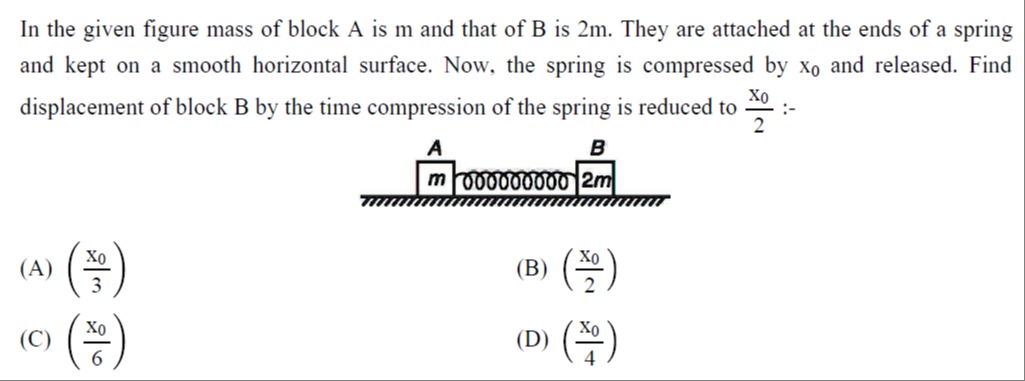Question
Question: In the given figure mass of block A is m and that of B is 2m. They are attached at the ends of a spr...
In the given figure mass of block A is m and that of B is 2m. They are attached at the ends of a spring and kept on a smooth horizontal surface. Now, the spring is compressed by x0 and released. Find displacement of block B by the time compression of the spring is reduced to 2x0 :-

3x0
2x0
6x0
4x0
6x0
Solution
The system consists of two blocks of masses m and 2m attached to a spring, on a smooth horizontal surface. Since there are no external horizontal forces, the total horizontal momentum of the system is conserved. Initially, the system is at rest, so the total momentum is zero. Therefore, the total momentum remains zero throughout the motion.
Let ΔxA and ΔxB be the displacements of block A and block B from their initial positions, respectively. Since the initial velocities are zero and the total momentum is conserved and equal to zero, we have: mvA+2mvB=0. Integrating this equation with respect to time from the initial state to the final state, we get: ∫mvAdt+∫2mvBdt=0 m∫xA,ixA,fdxA+2m∫xB,ixB,fdxB=0 m(xA,f−xA,i)+2m(xB,f−xB,i)=0 mΔxA+2mΔxB=0 ΔxA=−2ΔxB.
Let the natural length of the spring be L. Initially, the spring is compressed by x0, so the initial length of the spring is Li=L−x0. Let the initial positions of A and B be xA,i and xB,i. Then xB,i−xA,i=L−x0.
Finally, the compression of the spring is reduced to 2x0, so the final length of the spring is Lf=L−2x0. Let the final positions of A and B be xA,f and xB,f. Then xB,f−xA,f=L−2x0.
The displacements are ΔxA=xA,f−xA,i and ΔxB=xB,f−xB,i. Subtracting the initial length equation from the final length equation: (xB,f−xA,f)−(xB,i−xA,i)=(L−2x0)−(L−x0) (xB,f−xB,i)−(xA,f−xA,i)=L−2x0−L+x0 ΔxB−ΔxA=2x0.
Now we have a system of two equations with two unknowns ΔxA and ΔxB:
- ΔxA=−2ΔxB
- ΔxB−ΔxA=2x0
Substitute equation (1) into equation (2): ΔxB−(−2ΔxB)=2x0 ΔxB+2ΔxB=2x0 3ΔxB=2x0 ΔxB=6x0.
The displacement of block B is ΔxB=6x0.
